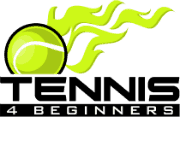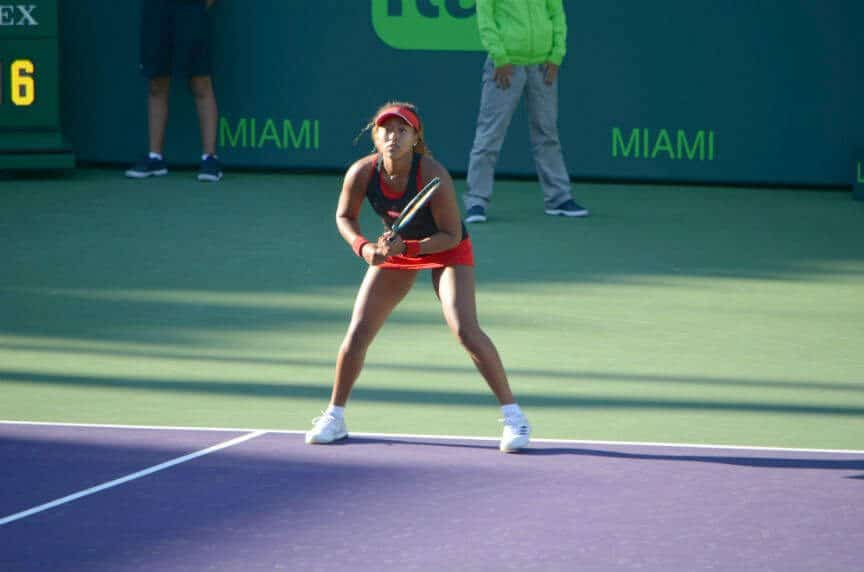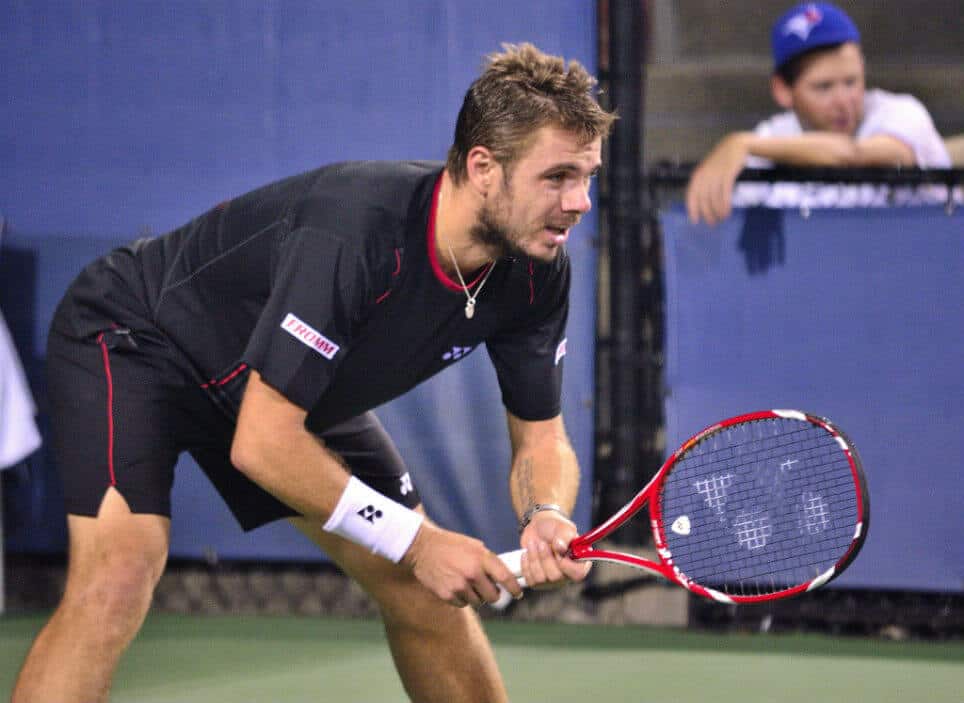The serve return plays a critical role in the game of tennis. During roughly half the match, your first shot taken will be a serve return. It’s important, therefore, that you develop a sound technique.
The serve return starts with proper positioning along the baseline. You should be in the ready position, leaning forward with the racket in front of you. A split second before your opponent makes contact with the ball, you want to rise and initiate a split step. Doing so will allow you to quickly shift your weight in the direction of the oncoming shot. Unlike regular groundstrokes, you do not want to bring the racket too far back. Instead, step into the serve using your bodyweight.
If you can diffuse your opponent’s serve and put them on the defensive, you gain a big advantage. A serve return can be either defensive where you block the shot, or it can be offensive in nature where you blast the ball back at your opponent or position the ball out of their reach.
1. Choose Your Grip
When returning serve, use the grip you would normally use on your forehand side as a starting point. If you normally play with an eastern forehand grip or semi-western grip, stick with those for the return.
If the server ends up hitting more to your backhand, you can consider switching over to your backhand grip. However, you can always adjust the grip to the backhand side once you know it’s coming that way even if you begin with a forehand grip.
What’s important is that you choose one or the other side. You don’t want to be caught in between grips and have to adjust every time. By choosing either a forehand or backhand grip, you will cut the need to adjust by about half.
Some players favor using a continental grip since it can be used on either side. However, unless you use the continental on your forehand shots, it will not feel comfortable to use this approach. For this reason, you are better off adjusting when required.
If you are new to the game or need to refresh your knowledge of the various grips mentioned here, be sure to check out the article on how to hold a tennis racket properly. You’ll find more detailed information on the various grips used in tennis.
2. Position Yourself Along the Baseline
Proper positioning along the baseline is critical during the return. Ideally, you want to position yourself halfway between where the server can stretch you on the forehand and backhand side.
If your opponent has a powerful serve, you may need to stand a few feet back from the baseline to have enough time to react to the shot. While this is often seen as defensive positioning, it may be necessary if your opponent is really blasting the ball at you.
If on the other hand, your opponent has a relatively soft serve, you can afford to position yourself in front of the baseline. This allows you to cut off the angle of the serve and go on the offensive immediately. This approach can work on second serves as well, as often times, second serves are less powerful than first serves.
Typically, at least until you start to get used to your opponents serve, you want to stand at about the baseline, maybe a foot or so behind. Equally important is the positioning either towards the corner of the court vs towards the center of the court.
Normally you want to stand a foot or so inside the singles sideline. However, if you sense your opponent is going to serve wide, you may want to adjust further towards the corner. If on the other hand, you sense your opponent is going to serve down the middle, you can adjust a bit towards the center of the court.
3. Start in the Ready Position
When setting up for the return of serve, you want to lean your body forward with the racket in front of you, head positioned higher than the handle. Use your non-hitting hand to help support the racket.
Some players like to sway or shift their weight from side to side as they await the serve. This can help keep your legs warmed up and at the same time allows you to get used to the notion of having to shift in either direction to return the serve.
Be sure to keep your eye on the ball from the toss to the time your opponent strikes the serve all the way through contact from your end. Following the ball with your eyes as long as possible, keep your head down and remain focused during contact.
Equally important is remaining loose and relaxed as you await the serve. It helps to exhale while you are waiting, and only once you hit the ball should you tighten up your body.
4. Create a Wide Base for Stability
You want to start out with your feet spread apart as much as possible for balance and stability. Your stance should be wider than shoulder width and you should bend your knees while leaning your torso forward.
Be sure to place your weight on the balls of your feet. You don’t want to get caught on your heels at any point. You can shift your weight back and forth as you await the serve in order to make sure you are not settling your feet.
At the moment your opponent tosses the serve, you will want to lift your body a bit in preparation for the split step to follow. The split step is a critical part of the service return as it will help set you up to quickly burst in the direction of the serve.
5. Use the Split Step for Quick Adjustment
The split step is essentially a quick hop forward and about 1″ off the ground. As you hop, you will land with your weight on both feet and your knees bent. This will essentially function as a coil position for your legs so that you can quickly react.
Once you see the ball coming, you will be able to spring in the direction of the serve. As you lunge towards either your forehand or backhand side, turn your shoulder towards the oncoming ball and bring the racket back just a bit.
The advantage of the split step is it allows you to react quickly and shift in the direction of the oncoming ball. You should perform the split step the moment your opponent makes contact with the ball on serve.
6. Keep Your Swing Short
Generally speaking, you want to keep the swing on the return short. Unlike a regular groundstroke where you will turn your body and bring your racket fully behind you, on the serve return you want to limit the swing and block the ball a bit in front of you.
This is particularly necessary when your opponent is a powerful server. You will not have time to turn your body sideways and bring your racket back to react to the serve. This is why you need to reduce the motion and just block the serve.
Essentially, you are using the power and speed of your opponent’s serve to generate the return. If the oncoming ball is hit hard you don’t need to swing hard, instead focus on positioning the shot and use the pace of the serve to your advantage.
The exception to this would be on a soft serve where you have the opportunity to take a full swing and really blast the ball, but even then the motion is a bit more contrived than on a regular groundstroke.
7. Use Your Bodyweight to Go Into the Return
The use of your bodyweight is a critical component of the return. Since you are limiting the range of motion on the swing, your weight will help provide the power you need to hit a strong return.
You want to shift your weight not only to the side of the return but also use your body weight to create forward momentum on the shot. Try to anticipate on which side the serve is coming and then shift your body forward at a diagonal towards the ball.
Don’t be afraid to commit to one side or another even though you’re not sure which side the ball is coming. If you are playing against a powerful server, it may be the only way to make contact in time. Eventually, you will learn to pick up cues from the server that will tip you off on where the ball is going.
From time to time, an experienced server will aim the shot right at your body to jam you. In this case, you would not shift your weight to either side, but the forward momentum principle would still apply.
8. Step Forward and Land on Opposite Leg
As you use your body weight to guide the ball forward, you will need to take a step forward to complete the shot. Your goal should be to get a quick first step. As you do this, you want to land on the leg opposite to your hitting side.
If you are a right-handed hitter, and the serve comes towards your forehand side, you would land on your left leg. Conversely, if the shot is to your backhand side you will land on your right leg.
For a left-handed player, the process would work in reverse. On the forehand the return you would land on your right leg. On the backhand return, you would land on your left leg.
Never back up to return a serve. You should always move into the ball. If you anticipate a powerful serve, position yourself further back before the serve. That way once the serve is hit, you can step forward into the ball.
Here’s a great video that shows you how to split step and transfer your weight during the return:
9. Recovery following the Return
After you have stepped into the serve, you have two options: You can either use the forward momentum to approach the net to set up for a volley or you can land and bounce back to recover in order to remain at the baseline.
Whether you chose one over the other comes down to how aggressive you want to play the point and how much time you have to make the move. On a powerful serve, chances are you will not be able to advance to the net.
The best choice, in this case, would be to recover and reset in the ready position in anticipation of the next shot. Remember, not every shot in tennis needs to be a winner. While hitting a powerful return shot past your opponent feels great, sometimes being patient and setting yourself up for the next shot is the best strategy.
10. Ball Placement
Ideally, you want to return serves deep into your opponent’s court. You don’t necessarily have to go for winners on every serve. In fact, just getting the ball back consistently (preferably deep) can be one of the most successful strategies you can employ.
Over the course of a match, consistency will beat hitting an occasional winner every few shots. If you place the ball well and get it in on a regular basis, you force your opponent to have to make the play. Often times that means they will miss their shot.
Placing the ball on a return is not an easy task. Particularly if your opponent has a powerful serve, you often times will only have time to react and get the ball back. However, as long you react quickly, step into your shots, and get the ball back consistently, you will put yourself in a good position.
Let’s take a look at a couple of placement strategies that you should aim for. When returning serve you have the option of going cross-court, down the line, or down the middle. The higher percentage shot is cross-court, although you can mix things up from time to time by going down the line particularly if it’s to your opponent’s backhand.
If your opponent rushes the net after their serve, ideally you want to place the ball at their feet so they have to scoop up the ball and likely hit back a floater which you can easily finish off.
On the other hand, if your opponent stays back at the baseline, return the ball deep so that they can’t approach the net. If your opponent hits their shot short following the deep return, you now have an opportunity to approach the net yourself, giving you an edge.
Final Notes
The service return plays an important role in your game. Keep in mind that for most players the serve is their most powerful weapon. If you find a way to diffuse your opponent’s serve and turn your return into an advantage, it will demoralize your opponent.
Rather than having to depend on long rallies to win your points, hitting winners on your returns can quickly tip a match in your favor. At the very least, if you position your returns well, it will give you the edge at the onset of any rally, rather than the server.
Many people view the serve as just another groundstroke. A forehand or backhand shot in response to a serve. However, as noted in this article, the service return has its own unique characteristics which differ from other groundstrokes.
In order to get good at returning serves, you must practice them regularly. One great way to do this is with a practice partner. They get to practice their serves, while you can practice your return. You can switch after a while so that you get some service practice as well. A win-win for both of you.
Share this Post


